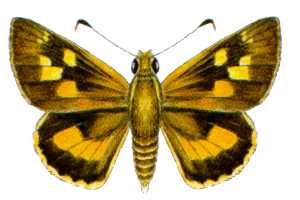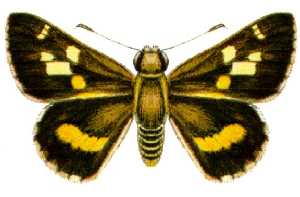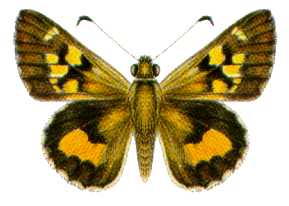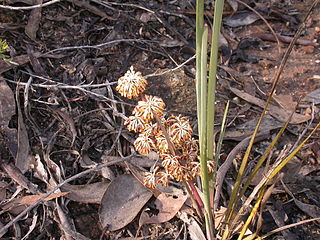
Acanthocarpus is a genus in the family Asparagaceae, subfamily Lomandroideae, in the APG III system of classification. It has been difficult to place at family rank, being placed at various times in Dasypogonaceae as well as the Asparagaceae. The entire genus is endemic to the State of Western Australia.

Trapezites eliena, commonly known as the orange ochre or eliena skipper, is a species of butterfly in the family Hesperiidae. It is endemic to Australia, where it occurs in Australian Capital Territory, New South Wales, Queensland, South Australia, and Victoria. It inhabits coastal or montane eucalypt forests.

Trapezites is a genus of skipper butterflies in the family Hesperiidae. All species are endemic to Australia.

Trapezites heteromacula, the orange white-spot skipper, is a butterfly of the family Hesperiidae. It is found on Australia's Cape York.

Trapezites iacchoides, commonly known as the silver studded ochre or iacchoides skipper, is a species of butterfly in the family Hesperiidae. It is endemic to Australia, where it occurs in New South Wales, Queensland and Victoria. It inhabits cool, temperate, open eucalypt forests.

Trapezites iacchus, the Iacchus skipper, is a butterfly of the family Hesperiidae. It is found in the Australian states of New South Wales and Queensland.

Trapezites maheta, the Maheta skipper or northern silver ochre, is a butterfly of the family Hesperiidae. It is found in Australia in Queensland and northern New South Wales.

Trapezites petalia, the common white spot skipper or black-ringed ochre, is a butterfly of the family Hesperiidae. It is found in the Australian states of Queensland and New South Wales.

Trapezites phigalia, commonly known as the heath ochre or phigalia skipper, is a species of butterfly in the family Hesperiidae. It is endemic to Australia, where it occurs in New South Wales, Queensland, South Australia and Victoria. It is primarily found in eucalypt woodlands, open forests, and coastal healthland habitats.

Trapezites phigalioides, commonly known as the montane ochre or phigalioides skipper, is a species of butterfly in the family Hesperiidae. It is endemic to Australia, where it occurs in New South Wales, Australian Capital Territory, Queensland and Victoria. It occurs primarily in open eucalypt forests, usually above 300 m (980 ft) altitude, extending up to 1,400 m (4,600 ft) altitude in subalpine woodland habitat in parts of New South Wales. The range of this species largely overlaps with the closely related heath ocre .

Trapezites symmomus is a butterfly of the family Hesperiidae. It is found in Queensland, Victoria, South Australia and New South Wales.

Trapezites taori, the Taori skipper or sandstone ochre, is a butterfly of the family Hesperiidae. It is found in a small area of the Blackdown Tableland in Queensland, Australia.
Trapezites macqueeni, the Macqueen's skipper, is a butterfly of the family Hesperiidae. It is found in north Queensland, Australia, in the hills away from the coast.
Trapezites praxedes, commonly known as the southern silver ochre or praxedes skipper, is a species of butterfly in the family Hesperiidae. It is endemic to Australia, where it occurs in New South Wales, Queensland and Victoria.
Trapezites atkinsi, the speckled ochre skipper, is a butterfly of the family Hesperiidae. It is found along the south-western coast of Western Australia.

Trapezites genevieveae, the ornate ochre skipper, is a butterfly of the family Hesperiidae. It is found in Australia along the coast of New South Wales and Queensland.

Lomandra effusa is a perennial, dioecious, rhizomatous herb native to Australia. It is a perennial tussock with bluish green, large, arching leaves which are distinctive by the two toothed leaf tip. It has white, cream or pink fragrant flowers during the months of June to October.

Lomandra multiflora, also commonly known as many-flowered mat rush, mat rush and many flowered mat-lily, is a perennial, rhizomatous herb found in Australia and Papua New Guinea. The mat rush is distributed widely in the region and common within its preferred growing conditions. Its conservation status is considered not to be of concern and risk.

The Iron-grass Natural Temperate Grassland of South Australia is a temperate grassland in the southeast of South Australia that stretches from Orroroo in the north, to Strathalbyn in the south, just straddling the eastern fringes of Adelaide's Mount Lofty Ranges. Listed as Critically Endangered under the EPBC Act, the grasslands predominantly feature Iron-grasses.
















